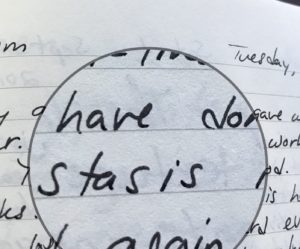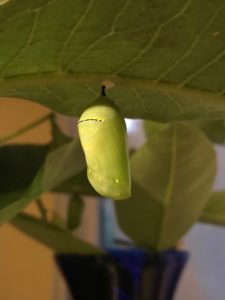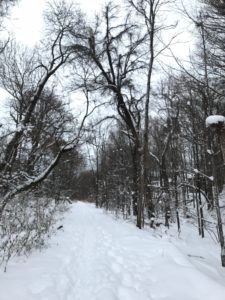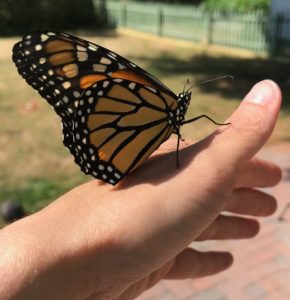Sta·sis /ˈstāsis/
Noun: A period or state of inactivity or equilibrium.

Prologue:
I started thinking about the concept of stasis as long ago as last fall when I jotted it into my journal, pondered through winter, and finally began writing in the first days of March. It was a good time to write about stasis after having allowed myself the rest; with spring about to arrive, I felt ready to awaken. Then, a pandemic happened, adding a whole different dimension to the topic of pausing in stillness. I continued writing as I originally envisioned the narrative, but be patient; I promise I found relevance in our present state of “pause.”
The Original Beginning
I’ve twice written about raising Monarch butterflies (here and here); letting milkweed claim a portion of my back garden, carefully searching the underside of the leaves for the unmistakable alien-like eggs, then nurturing tiny caterpillars through massive growth cycles. The whole process is a study in patience and transformation. Perhaps the most intriguing part for me — and the most critical part for the butterfly — is what comes after the feeding frenzy and staggering growth:

Monarch butterfly in chrysalis
The Chrysalis.
Once the caterpillar finds a safe spot to shrug off it’s outer skin, she then rests for about 10 days. It is a time of utter stillness after the “hungry little caterpillar”-phase. Nothing seems to be happening. During this outer stasis, deep within the chrysalis a magnificent transformation is taking place.
After Persephone
Nature is the mistress of both growth and stasis, change and constancy, movement and rest. The parts of the world that fully experience all four seasons witness this annual give and take. The earth has already been long-planning for a rest once daylight recedes, the leaves fall, and the last of the jack o’ lanterns stop grinning. The freeze and snow of winter is a blanket drawn up to the earth’s chin. Nothing even tries to grow. It’s time to wait, rest, and replenish.

The Return of Persephone | Smithsonian American Art Museum, Transfer from the Archives of American Art, Smithsonian Institution
The Ancient Greeks explain winter as a season of longing and sorrow — i.e.: Grief.
As the story goes, Hades simply wanted Persephone so he interrupted her flower-gathering to steal her away to the underworld. (Never mind that Hades was her uncle, that Zeus, her father, consented to the abduction, and that the truth of the story has been whitewashed into “Hades wanted her for his bride.”) Demeter, goddess of fertility and the harvest, was so stricken at the loss of her daughter, Persephone, that she allowed the earth to lie fallow as she grieved.
Since Zeus can’t really abide a fallow earth (i.e.: famine, and who would be left to worship him?), he commands Hades to release Persephone. Of course, not before she is tricked into eating six pomegranate seeds and — yadda yadda yadda — she is obliged to return to the underworld for six months each year.
Spring is the annual herald of Persephone’s return to her mother; with Demeter’s joy, the earth can awaken and grow again.
Does a time of sorrow have to invoke stasis? If you consider the purpose of grief, then, yes, perhaps it should. Grief is critical to the healing process, so clearing the space around us, physically and figuratively, of extraneous activity gives us what we need to do that internal work.
Every pang of heartbreak and every tear while we grieve is remembrance of something important to us, and acknowledgement of the pain of its loss. Eventually, just like winter, the harshness of a season in grief will soften and it will be a time to begin moving again. This isn’t to say that we might not cycle back to grief-stasis. After all, winter always returns.
A Season
Some years ago, enduring my treatment for cancer included a number of uncomfortable side effects. Among these was that my digestive system couldn’t tolerate dairy. While the entire situation was extraordinarily inconvenient, and there were a number of foods I couldn’t tolerate, I became fixated on the fact that cheese was a no-go. With so few pleasures, life without cheese was misery.
A good friend (who happened to be quite pregnant at the time) patiently listened to my outpourings. Then with nothing but grace and kindness, and not a hint of platitude, she said to me, “There are foods I have to avoid while pregnant, but I know once I have this baby I can enjoy them again. This is just a season. A season is not forever.”
A season. A part of the cycle. A fixed time. A time with a purpose.
Winter Slumber
In winter, the earth simply waits. Nature has prepared all of her fauna and flora. It is a forced rest and a necessary part of the cycle.
Birds that migrate do, and those that don’t hunker down to roost whenever possible, even slowing their metabolism to conserve energy as necessary. Fish do the same and amphibians can fully “turn off” into hibernation, as do woolly bear caterpillars.

Trees let their leaves go in autumn after storing up enough photosynthetic energy to survive winter. Garden perennials do the same, storing energy in the roots sleeping deep below the soil line. Even the slumbering seeds of wildflowers scattered by the wind have sense enough to stay curled up until the soil warms.
Winter is a resting earth.
I used to feel like a pale shadow of myself during winter; the season chafed, feeling like a plodding, painful waiting game for life to return. After wrestling with the season in my very soul for more than four decades, I’m finally ceding the fight.
If I want to nap and Netflix through a winter, I can. Nature has been modeling since the beginning of time that it’s okay to just take a rest.
The Threat of Constant Growth
A lot can happen over a winter. Or nothing at all. Or both, as is the case with the monarch chrysalis.
A friend and I have been contemplating the concepts of growth and stasis. This winter she wrote on her Instagram:
When I worked for the local business journal, I wondered why every company we interviewed would invariably claim to be “on a growth track.” Never once did anyone say, “we are taking stock of where we are and focusing on our current customers,” or anything remotely similar. Constant growth? It’s unsustainable, for anyone or anything.
Everywhere we turn, there is an emphasis on growth. Grow your client list, grow your services, grow your profits, grow your bank account. While there is nothing inherently wrong about any of those goals, it’s a pace that nature just does not intend.
Is constant growth sustainable? One type of unsustainable growth in a human or animal is cancer. Out of control cellular growth results in a tumor. Unchecked, the tumor takes over the entire organism. When the organism’s various processes and purposes are overwhelmed, it dies. A virus acts in much the same way.
The Crocus Knows
It would seem that people in general didn’t get the memo about the value — nay, the imperative — of stasis. Look at us all making New Year’s Resolutions not even two weeks into winter proper. While all of nature is modeling rest. Madness.
A far better benchmark for beginnings is the first day of spring, on or about March 20th. Now, March (and, in these parts, April) may be a month when winter grapples with spring on a daily basis, but no birth is without its paroxysms. Spring is wake-up time. The crocus knows what’s what.
Remember the hungry little caterpillar in its chrysalis? Well, it’s not actually a caterpillar in there anymore. It’s just goo. It can’t make its dramatic transformation without the long rest. Why should it be any different for humans? In fact, if we want to get the most out of our growth periods, we really should accept that a period of total rest is prerequisite. If only humans could truly hibernate. Or quietly devolve into goo while we transform.
Stasis 2.0
Stasis is not easily quantifiable. How can you count or measure something that isn’t happening? Especially now, with social distancing to contain Covid-19.
(Ah, there it is. I promised we’d get here.)
As of this writing, we are officially just over one month in since New York state went on ‘pause.’ Also officially just over one month since the first day of spring. Just when we were supposed to begin awakening alongside the earth.
While it is still certainly spring, and the crocuses are long up, human beings around the world have been forced back into stasis. The absolute gall of the Universe.
Go-go-go is no more! We’re at a 100% workforce reduction in New York; if you can work from home, you must. If you cannot and are “non-essential,” … you must simply wait.
It’s hard to write about an event in the midst of the event. Others are doing a far better job than I of assessing what the post-pandemic world will or should look like, politically, socially, economically, and cosmically. I’m personally stuck in a space of being ready to grow alongside the plants in my garden, but sidelined to spectating while those soft green first-leaves shake off the soil.
While I first conceived this post to be about the benefits of stasis and an indictment of a society that devalues the concept, I’m now not so certain. I suppose, like the person who puts away the snowblower the day before an early spring snowfall — I’m sorry?
This time, with wings

To be clear, this pause — this enforced, unnatural stasis — is not sustainable either. We can’t stay like this and, like the caterpillar-gone-to-goo, we can’t go back. Like Demeter, we are certainly experiencing a sorrow that feels like death (if not mourning actual deaths from Covid-19).
I’m trying to remember “this is a season,” this social distancing. But the finish line keeps moving. We’re not supposed to be hibernating right now.
Maybe I need to remember why I started writing about stasis to begin with, before the world turned upside down. Maybe it will help to remember what observing the life cycle of the monarch butterfly has taught me:
Who are we, really, on the inside? Sometimes it’s a whisper, even to ourselves. Transformation happens when we take the time to close off from the world and care for that inner, quiet, and sometimes secret, self. Some will miss the caterpillar. Some will pass by and not even notice the process. This change is hard. It takes time and patience. It can feel lonely, like being compressed in a small place. But when the time is right, you will emerge. You’ll expand out of that small space and be entirely, magically, new.
Who will we be at the end of this season? How will our worlds and our very selves be transformed? What will stasis have finally told us? And will we be ready to listen?

